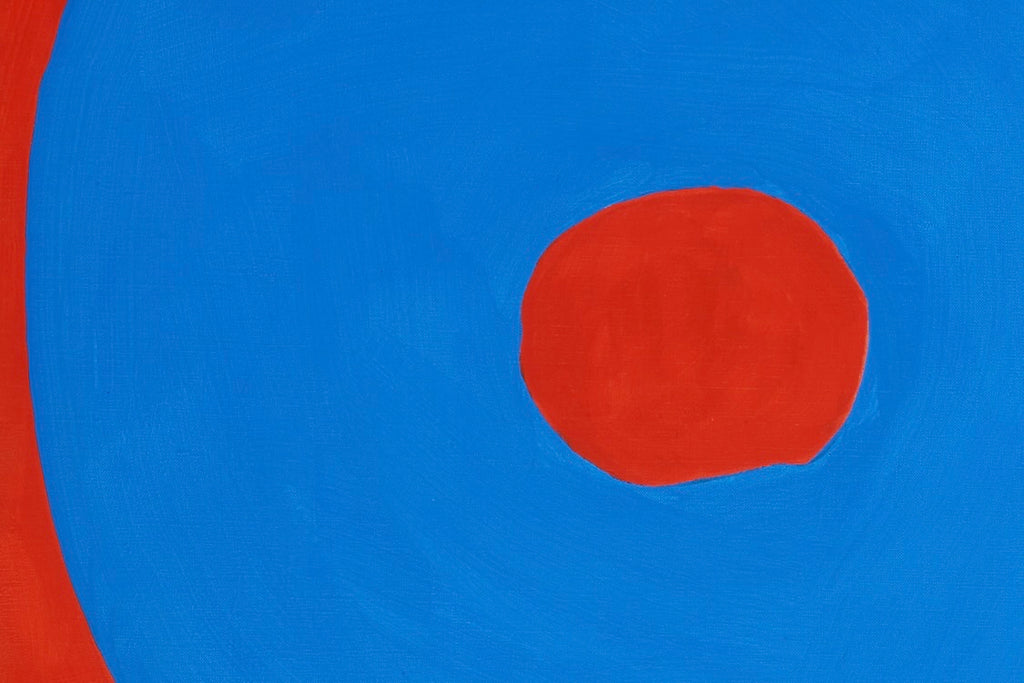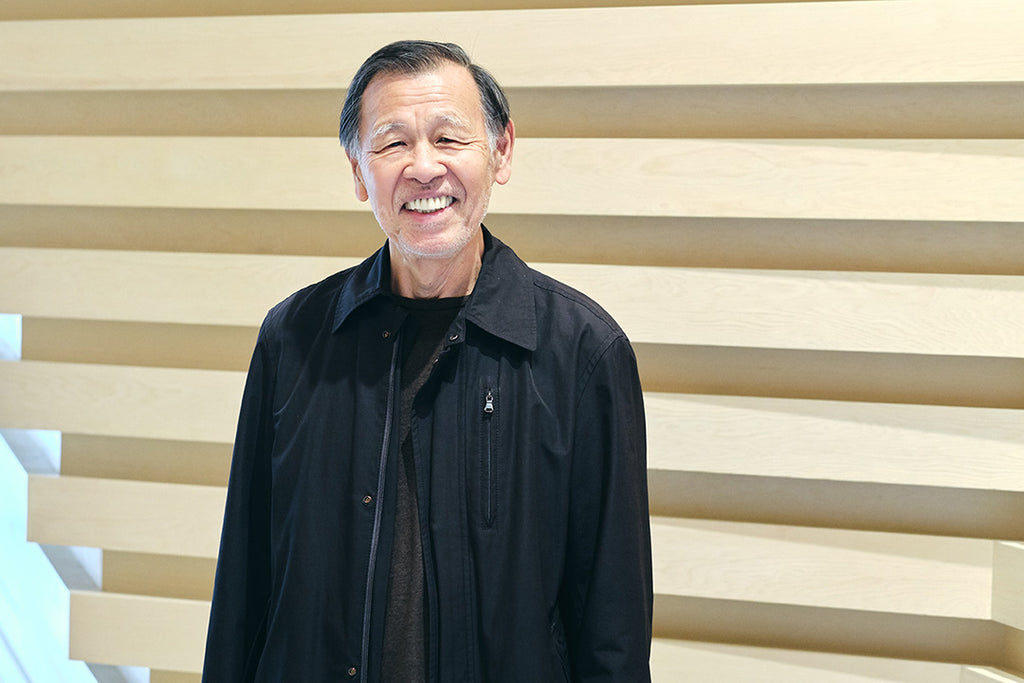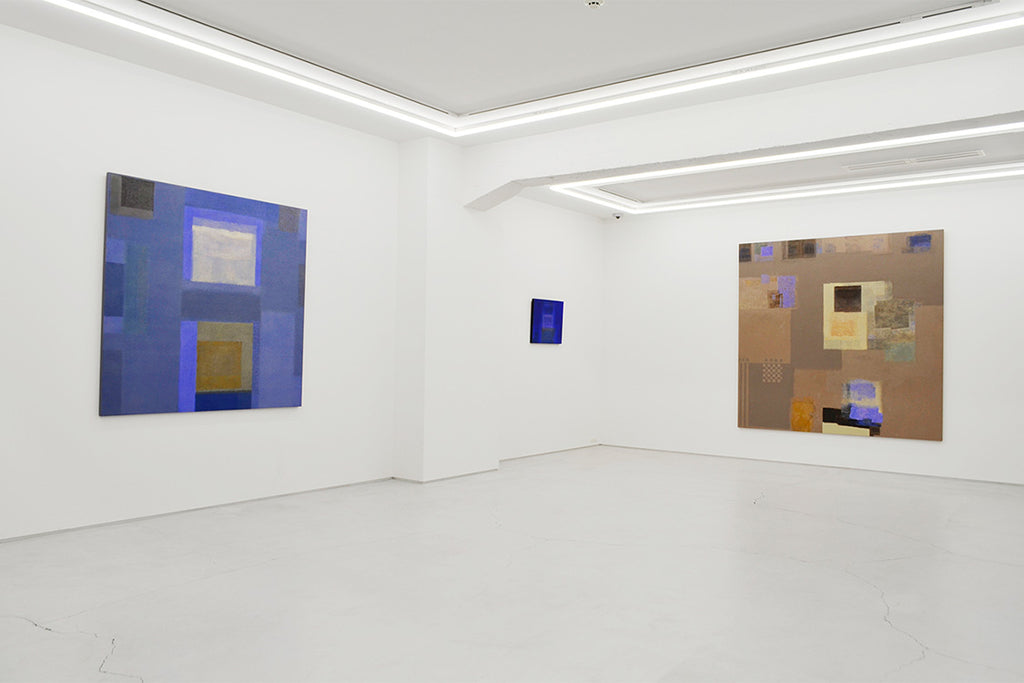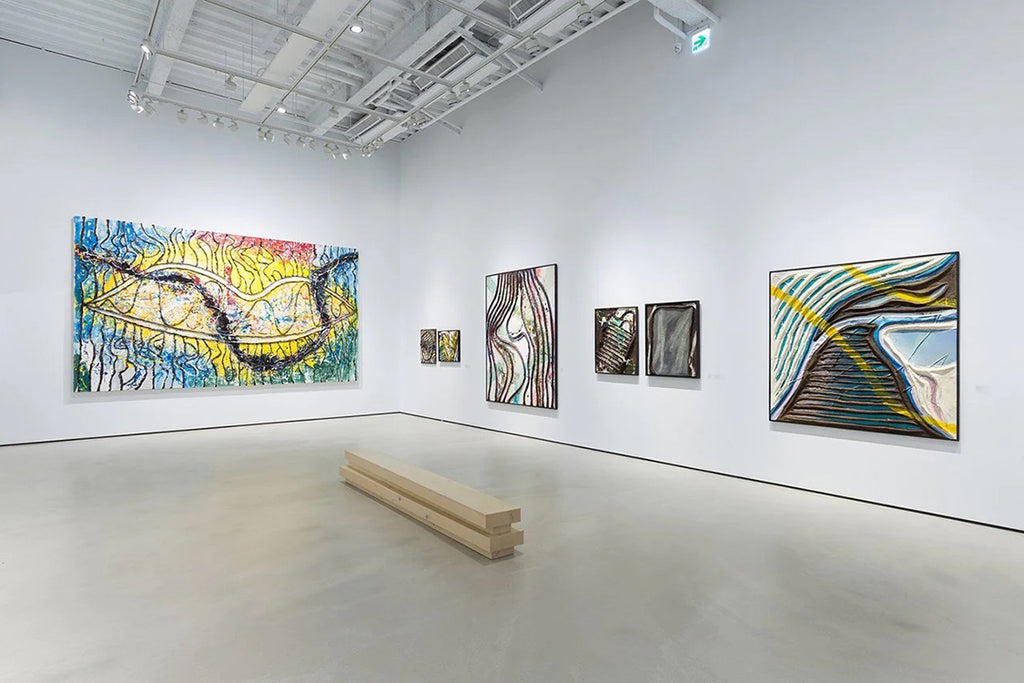ARTICLES
Powerlong Art Museum, Post-War Japanese Art, and Gutai Art
A New Appreciation Contemporary Japanese and Asian Art
15/23

A New Appreciation Contemporary Japanese and Asian Art
In our ongoing series, we present the digital archive of the book 'A New Appreciation Contemporary Japanese and Asian Art' This book delves into internationally acclaimed artists and the dynamics of the Asian art market. The fifteen installment features dialogue between Yukio Shiraishi, Wendy Xu, and Yuhzou Hua.
Powerlong Art Museum, Post-War Japanese Art, and Gutai Art At Powerlong Art Museum|Interviews of Experts in the Art Industry
Yukio Shiraishi
Chairman, Whitestone
Wendy Xu
Operating Officer, Powerlong Art Museum, Shanghai
Yuhzou Hua
Art Collector
Recently, post-war Asian contemporary art is receiving international attention and is being highly acclaimed. What is the background of such situation and what is the reality of the situation? Three people active in the front lines as art dealers and curators gathered for the talk.
Yukio Shiraishi, CEO of Whitestone Gallery, Yuhzou Hua from HWA’s Gallery in Shanghai, which focuses on introducing post-war Japanese art, and Wendy Xu from the Powerlong Art Museum with in-depth understanding of Chinese and Japanese art, reflect on the paths of Chinese and Japanese art, especially post-war art around the Gutai as well as the current situation of the international art market and their challenges in it.

From left to right: Yuhzou Hua, Yukio Shiraishi, and Wendy Xu
Powerlong Art Museum: Passionate Glances over Contemporary Asian Art
Xu: First, I would like to thank Mr. Shiraishi for visiting the Powerlong Art Museum again. I am honored to be introduced to Mr. Shiraishi through Ms. Yuhzou Hua. To understand this museum as best as possible, I toured Mr. Shiraishi throughout the museum. We are a very young museum that opened its doors just one year ago, and this is the first time our collection was displayed. As you can see from the exhibition, our collection consists of modern and contemporary calligraphy works and the works of artists like Baishi Qi whose name uses the same Chinese characters as that of Mr. Shiraishi, in addition to works by Daqian Zhang, Beihong Xu, and Zhou Huang.
This museum is designed in a round-shaped hall. We would like to display “small yet sensitive works” in this space. We will build our collection slowly and little by little and would like people to see the masterpieces from all over the world, including the works of Japanese artists. That is why we started collecting the works of Japanese artists.
Since last year, we planned to start our collection from traditional modern and contemporary artists and have acquired the works of important Chinese artists like Xiaogang Zhang. Following Chinese artists, we felt we should acquire the works of non-Chinese artists, and thus, set up the concept and started contacting international artists through friends, galleries, and various art institutions. As expected, we often learn about the situation through auction houses as well.
Post-war art or Japanese artists are a big stream in art. There is continuity and an eternal history in it. Thus, we learned the history and sought to find the artists we liked. Through that process, with regards to overseas artworks other than those originating in China, we found it necessary to start with East Asia. Japan is among the most important. Japan is, of course, a representative country of the Eastern art world. We acquired works by Yayoi Kusama and Yoshitomo Nara. Their expression styles attract people to their works. Their works not only have the characteristics of the East, but are also filled with international elements. Our collection has just started, and we are hoping to acquire more works by important Japanese artists.
I am very honored that Mr. Shiraishi found our collection valuable. The Powerlong Art Museum was founded with the mission of enhancing the spirit of traditional cultures and promoting the development of contemporary art. To fulfill the social responsibility of art education, the collection needs to be selected based on the contexts and dimensions.
Our calligraphy collection exhibition systematically arranges the masterpieces from modern to contemporary from various perspectives.
We hope that this exhibition serves its role in the continuous development of art. Mr. Shiraishi may feel a deep impression, especially to the Japanese artists like Yayoi Kusama, Yoshitomo Nara, and Atsuko Tanaka. After World War II, Japanese society was full of desperation and loss of hope. As the militarist ideology disappeared, many artists started to pursue individuality and self-autonomy, which resulted in denial of blinded worship of western art. Under such historic background, artists with innovative minds were born one after another in Japan. Gutai, a representative school in Japan, was born under such circumstances. Yayoi Kusama, the queen of dots, is a symbol that fully expresses her ego. Yayoi Kusama stayed in the United States when she was young and started exploring her own avant-gardeness to build her own style. Japanese post-war artists are worthy of attention, so it is worth digging deeper. They have created a cultural phenomenon and have become a target of research.
Hua: Mr. Shiraishi has fifty years of experience in the art world. Mr. Shiraishi sought to work in the field of art when he was around twenty. At that time, the center of art was in Europe, especially Paris, France.Accordingly, Mr. Shiraishi introduced major European paintings, such as Impressionism and École de Paris, to Japan. Was it through that process that you find the need to deepen your understanding of Japanese art?
Considerable Influence of Traditional Chinese Art to Japan
Shiraishi: Although I mainly handled European paintings then, I was hoping to further study the art of my own country. By learning Japanese art, I understood that Japanese culture was influenced by Chinese culture throughout the times.
I saw the Powerlong Art Museum under the guidance of Ms. Yuhzou Hua.
In the massive museum, I enjoyed an ink-painting collection that had been collected since her grand-father’s generation. I could also see the works of representative Chinese paintings.
For instance, the ink-painting by Baishi Qi. My sir name uses the same Chinese characters, and I have seen many works by Baishi Qi in Japan. When I was younger, I was thinking that there were also Japanese artists who depict nature, figures, and still objects like Baishi Qi. But I now feel that these artists were influenced by the masters of Chinese ink-painters like Baishi Qi. Japanese art has developed its culture unique to island countries, such as ukiyo-e; however, many of them have arrived from mainland China. In fact, more than seventy percent of the culture came from China and spread throughout Japan via the Korean peninsula.
This insight struck me. There are countries on the Earth that have long histories and unique cultures. Between China and Japan, there is a relationship that is inseparable and difficult to straighten out. However, there is also a mutual respect between us that was cultivated throughout the times.
This mutual respect is an important legacy that history and culture left to us, and will be a bridge between China and Japan. Long time ago, I had a several chances to stay in China with a master Japanese artist, Ikuo Hirayama, when he attended Japan-China cultural exchange events. I remember Mr. Hirayama visiting China for a lecture saying that there is so much to learn about Chinese culture.
Post-war Japanese art, that is, contemporary Japanese art, is a cultural system formed under the influence of post-WWII Europe. However, when we look at Japanese art in a longer span, it is China that influenced Japanese culture the most. Chinese culture has a significant impact over us and is becoming an underlying source of energy for us. Artists like Yayoi Kusama, Yoshitomo Nara, and Miwa Komatsu, who have been very active lately, will probably put the focus of their business in China.
Whitestone Gallery will also bring great works of Yayoi Kusama and Gutai Art to do exhibitions in China. One more thing, after I visited the Powerlong Art Museum last time, I came up with another way to deepen China-Japan cultural exchanges. I would like to recommend the Japanese tourists to visit the Powerlong Art Museum in Shanghai.
Hua: I am very honored to have such a recognition and high evaluation. Japan’s Gutai Art was started by Jiro Yoshihara in 1954, ten years after the end of WWII and the beginning of Japan’s economic growth. Could you explain how it was developed?

Exhibition space of the Powerlong Art Museum where the works by Gutai-style artists can be seen.
On Gutai Art Association, the Pioneer of Post-War Japanese Art
Shiraishi: When the war ended in 1945, Japan was devastated. By watching the aftermath, we realized the wrongness of war and started rebuilding the country. From there, Japan started seeking the means for survival in international society. Social transformation from militarism to democracy brought freedom and peace in art. Japanese paintings flipped 180 degrees to innovation, concept, and creativity, and the painters sought to pursue their originality. Its pioneer was Jiro Yoshihara, the founder of the Gutai Art Association. Under the motto of “Never imitate others: make something that has never existed before,” Kazuo Shiraga fought with mud in the corner of a park and Atsuko Tanaka created her one and only performance wearing an electric dress.
The Gutai Art Association conducted exhibitions in galleries and museums throughout the world in places including the United States, Paris, Italy, and Germany between 1952 and 1972, when Jiro Yoshihara passed away. Their works from this time period have been collected in museums including the Museum of Modern Art, New York and the Centre Pompidou in France. I am grateful for that and was moved by seeing the Gutai works collected in the Powerlong Art Museum.
Hua: Recently, collectors in the west and China are very much interested in post-war Japanese artists like Gutai and Mono-ha. Why is that?
Shiraishi: Achieving economic growth, Germany and Italy looked at post-war art and started reevaluating it. The works by Heinz Mack from Group Zero, Otto Piene, Lucio Fontana, Yves Klein and so on were being sold at galleries and auctions at high prices, and post-war Japanese art was also starting to receive attention.
The recognition and market of the Gutai Art Association gained attention after the 2013 exhibition Gutai: Splendid Playground at the Guggenheim Museum. This exhibition became an important point in re-evaluation of the Gutai. However, the value of post-war Japanese art is only one one-hundredth of that of American art, and one-tenth of that of European art. Since the fundamental philosophy of post-war art in defeated countries like Germany, Italy, and Japan are the same, there has to be more potential for re-evaluation and market expansion of post-war Japanese art.
Using this opportunity, I would like to briefly summarize the relationship between post-war Japanese art and international art. As I said before, I first worked in the field of Impressionism, École de Paris, and so on.
Upon participating the Armory Show in New York, I was dealing with the organizers to participate the art fair with the works of Japanese artists like Taikan Yokoyama and Higashiyama Kaii, who were high in demand domestically. However, I was asked from the organizer to bring the Gutai artists’ works that were receiving much attention in the United States. That made me to realize that New York and world market were focusing on Gutai. I therefore brought the works of four artists, Kazuo Shiraga, Atsuko Tanaka, Shozo Shimamoto, and Sadamasa Motonaga.
Surprisingly, at the art fair, local museum curators and collectors from all over the world rushed to our booth for the artist’s portfolios. I never expected such a high response. I was also moved by the fact that Gutai was well-received in New York, the center of contemporary art. Through the art fair, I came to know the then-largest collector and was able to build a good relationship with western collectors for the first time through Gutai.
There is a very famous painter called Jackson Pollock in the United States yet he died at early age. When people related to him cleaned up his studio, they found a lot of journals published by the Gutai Art Association. That was how we knew that Pollock was obtaining inspiration from Gutai. It goes without saying how much shock and impact it gave to the world of art in the United States.
Furthermore, it was also found that Pollock introduced to the media that Gutai artists was also doing the same dripping method, his unique style, which creates dynamism using extensive amount of paint. Also, Pollocks’ abstract expressionist style that creates multiple perspectives on the seemingly homogeneous surface and his all-over style greatly influenced Kazuo Shiraga and other Gutai artists.

Exhibition space of the Powerlong Art Museum where the works by Gutai-style artists can be seen.
From Learning to Creating Individual Originalities
Shiraishi: Japan lost WWII and the whole country was devastated with atomic bombs dropped in Hiroshima and Nagasaki. All the Gutai artists experienced the war. Through their experiences, they felt that freedom and peace are needed to revitalize the country. With the belief that art should be that way as well, they learned the creative spirit from the Gutai leader, Jiro Yoshihara.
Until then, art in Japan and China was something to learn from teachers and masters. However, post-war art after the drastic social change transformed into artworks full of originality. For instance, Jiro Yoshihara did an exhibition of Gutai artists not in a gallery or museum, but outdoors (in a park).
It was based on the Gutai philosophy: “Never imitate others: make something that has never existed before.” Sadamasa Motonaga created his “water sculpture” by filling a bottle with colored water. Kazuo Shiraga created his work using his body by fighting with the mud in the park. Michel Tapié, a French art critic and advocate of Arte Informale, later said that their works were quite avant-garde and radical compared to the international history of art.
There is another story. Jiro Yoshihara completely disapproved many of the works that Shozo Shimamoto created then. Shozo Shimamoto had no clue what to do. In one morning, Shimamoto found a hole on the newspaper as he touched it with his wet hand. Shimamoto felt that this was what happened for the first time in the world and showed Yoshihara the result. Yoshihara responded, “This is truly the first” and highly praised Shimamoto’s action, and thus, this became his first work. Lucio Fontana in Italy also created a series of works, Concetto Spaziale, which was made by cutting the center of the canvas. However, according to the date on the newspaper that Shimamoto cut, his work was created before Fontana. Since Shimamoto did not have money to buy canvases, he used layered newspapers as a canvas. Therefore, the date the work was created was very precise. Later on, there was a big debate that received international attention in the field of art over who started this style.
Hua: How was it when the Whitestone Gallery first endeavored abroad?
Shiraishi: The first exhibition we did was in Moscow. Later, I brought Japanese contemporary art to Moscow to do an exhibition at the national art museum. There was an artistic creativity in Moscow then, which sought to connect to international art. It was the first time I touched the world outside of Japan.
In the United States, the trends of the 1950s was continuing, which was the interest to have exchanges with modern paintings in Japan. It was much later that they started worshipping Gutai Art. Through these exchanges in art, I came to think that competition in art creates exchanges and mutual inheritances while political conflicts result in war. Therefore, I believe that art has no boundary and can create mutual exchanges.
Speaking of Japan, the post-war art as I understand is a new philosophy to restructure society in the ruins of the defeat and to propose it to the world through art. By losing the war, we learned the importance of peace, realized what to proceed in art, opened art internationally, and filled the world with peace and freedom.
Founding the Art Fund as the Engine to the International Market
Hua: Fifty years have passed since you started working in the world of art. As I understand, you are hoping to leave a universal art filled with love and peace. To do so, you have been making endless efforts by founding a new system, establishing an art fund in Japan, and seeking to extend the post-war art to the whole world.
Shiraishi: Yes. The art fund that I am about to start will feature post-war Asian art that is valued internationally. The first fund features post-war art like Gutai and Yayoi Kusama. The second and third funds will include post-war artists throughout Asia. Hopefully, the investment effect can be seen within a few years. For instance, if the value of the work of Japanese or Asian artists becomes ten times higher, the evaluation of these artists will drastically change. There is a tenfold difference between the price of works by Fontana or post-war German artists whose name came up earlier, and that of post-war Japanese artists. The gap increases to a hundredfold when comparing them with Pollock and other American Abstract Expressionists. I believe that this art fund will act as a catalyst for the contemporary art market and bring further evaluations for the growing Japanese and Asian artists to build their firm positions in the world.
You have consistently introduced post-war Japanese art for the past decade in Shanghai. I appreciate it very much. Could you tell us how you encountered Japanese art?
Hua: I studied in Japan during my schooldays and majored in art history. I am very aware of the culture and economic development of Japan and am thinking seriously of how to proceed with the friendly exchanges between China and Japan, especially in the field of art. In November last year, the solo exhibition of Tsuyoshi Maehara, a second generation Gutai artist, was held at the HWA’s Gallery in the Powerlong Art Museum, and many of his works were acquired by collectors in Shanghai including the Powerlong Art Museum.
Seventy years since the end of the war, the international art market has reevaluating post-war art. What kind of reevaluation do you hope for post-war art?
Shiraishi: Whitestone Gallery seeks to introduce specifically post-war Japanese art and Gutai among various art activities in the world. Through collaborations with auction houses and museums, we seek to further expand the market of these groups. Since 2010, the evaluation of Gutai and Yayoi Kusama has been continuously increasing.
I especially remember Kazuo Shiraga’s work from the 1960s that was auctioned at over ten million dollars at Sotheby’s, Paris.
Also, Yayoi Kusama’s work was used to decorate the cover of the auction at Hong Kong. These show that the market is focusing on Japanese artists. This year, the works of post-war Japanese artists will be included in the art fund, which will further activate the market.
Hua: Art is an important industry for the country. In addition to respect for the history and culture of the country, it is necessary to pursue new forms of art. What do you see in the future of the art market in Japan and China? Also, what will be needed to develop the art market?
Shiraishi: To activate the art market, cooperation among galleries, museums, auction houses, and art funds is very important. The galleries in international cities such as Hong Kong especially reflect the direction of the market very strongly. As for the activation of the market, we are planning a series of art events during the 2020 Olympic season at the museum in Karuizawa that Whitestone manages. We would like to introduce Japanese and international artists to people all over from the world during this occasion when they visit Japan.
There are no borders in art. We hope that the tourists who may not have many opportunities to see art will feel the power of art through these events.
Hua: Currently, forty-two percent of the international art market is occupied by the United States, while China occupies twenty-one percent, which is more than the share of Europe. China has become the second largest presence in the art market. In China, we can see that the masterpieces are bought back through the auctions, and the evaluation of local art is becoming higher. At the same time, to better understand the culture of other countries, Chinese collectors collect Japanese art or contemporary art from the west. What do you think of this phenomenon? Xu: It is certainly true that a circulation of artworks has been happening over the last two years or so. After WWII, the world became unified and diversified. In Japan, exchanges and unification with western culture was accelerated. Artists studied traditional art while understanding the core of western contemporary art and created works with completely new vocabulary. In China, the importance of cultural programs has been recognized, and museums have been built. All of these are pushing the circulation of artworks in China.
Many museum founders are also showing their collections to the public, which is a very meaningful thing to art lovers. Such changes created chances for us to explore the artworks from different countries.
It is natural for us to preserve artistic treasures for China as a means to develop art in China.
Hua: Today, we have talked a lot about Gutai and other post-war Japanese art. I would like to ask Ms. Wendy Xu about plans in the Powerlong Art Museum. I have great expectations.
Xu: I am thinking a lot from our conversation today. Mr. Shiraishi has very rich experience and respects the history of art he experienced in the last fifty years and the relationship with the artists. As a museum, we worked together with the Samsung Museum and the National Museum of Modern and Contemporary Art in Korea for organizing Korean Abstract Art: Kim Whanki and Dansaekhwa. The newly opened 500 Years of Western Painting is a collaboration with the Tokyo Fuji Art Museum in Tokyo. I am hoping to further develop collaborative relationships with many more art institutions.
Mr. Shiraishi’s gallery is also one of them. It has a lot of important works that are worth displaying and carries many works from emerging artists. Through the Powerlong Art Museum, I am hoping to provide great exhibitions to Chinese people. I am, therefore, very glad to have Ms. Hua and Mr. Shiraishi here today to have a chance to have this conversation.
Shiraishi: Art is what needs to be studied by everyone. From our conversation today, I could see that you have many great friends and networks with great art institutions. With the potential that the Powerlong Art Museum has, we can move towards a better future. Thank you very much.
Book Information
Title: A New Appreciation Contemporary Japanese and Asian Art (English Edition)
Publisher : Whitestone Co., Ltd.
Release Date : February 26, 2020
*Information in this article is at the time of publication.



